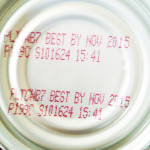 I was talking to a friend and this came up: Do Expiration Dates really matter?
I was talking to a friend and this came up: Do Expiration Dates really matter?
At first I thought…. well, yeeeaah. They’re put on there for a reason. But after a moment or two, I thought about the expired ricotta cheese I once smelled then ate, and didn’t die.
So I thought I would do a little investigation to know what’s ‘safe’ and what’s not.
Here’s the research:
According to WebMD
“The only items required by federal law to be labeled for expiration are infant formula and some baby foods; some states also mandate pulling dairy from store shelves on the expiration date”.
So it’s not even required!
They go on to explain the labeling and what it means:
- Sell by” date. The labeling “sell by” tells the store how long to display the product for sale. You should buy the product before the date expires. This is basically a guide for the retailer, so the store knows when to pull the item. This is not mandatory, so reach in back and get the freshest. The issue is quality of the item (freshness, taste, and consistency) rather than whether it is on the verge of spoiling. Paul VanLandingham, EdD, a senior faculty member at the Center for Food and Beverage Management of Johnson & Wales University in Providence, R.I., tells WebMD the “sell by” date is the last day the item is at its highest level of quality, but it will still be edible for some time after.
- “Best if used by (or before)” date. This refers strictly to quality, not safety. This date is recommended for best flavor or quality. It is not a purchase or safety date. Sour cream, for instance, is already sour, but can have a zippier, fresh taste when freshly sour (if that’s not an oxymoron!)
- “Use by” date. This is the last date recommended for the use of the product while at peak quality. The date has been determined by the manufacturer of the product.
Now we’re at the ‘meat’ of it, so to speak:
- Milk. Usually fine until a week after the “Sell By” date.
- Eggs. OK for 3-5 weeks after you bring them home (assuming you bought them before the “sell by” date). VanLandingham says double-grade As will go down a grade in a week but still be perfectly edible.
- Poultry and seafood. Cook or freeze this within a day or two.
- Beef and pork. Cook or freeze within three to five days.
- Canned goods. Highly acidic foods like tomato sauce can keep 18 months or more. Low-acid foods like canned green beans are probably risk-free for up to five years. “You do not want to put cans in a hot place like a crawl space or garage,” Peggy VanLaanen, EdD, RD, a professor of food and nutrition at Texas A&M University in College Station, Texas, tells WebMD. She suggests keeping canned and dry food at 50 to 70 degrees Fahrenheit in a dry, dark place. Humidity can be a factor in speeded-up deterioration. The FDA notes that taste, aroma, and appearance of food can change rapidly if the air conditioning fails in a home or warehouse. Obviously, cans bulging with bacteria growth should be discarded, no matter what the expiration date!
Food Safety Tips
Since product dates don’t give you a true guide to safe use of a product, here are some other tips from the U.S. Department of Agriculture Food Safety and Inspection Services:
- Purchase the product before the date expires.
- If perishable, take the food home immediately after purchase and refrigerate it promptly. Freeze it if you can’t use it within times recommended on the chart.
- Once a perishable product is frozen, it doesn’t matter if the date expires because foods kept frozen continuously are safe indefinitely.
- Follow handling recommendations on product.
| Item | Storage Times After Purchase |
| Poultry | 1 or 2 days |
| Beef, Veal, Pork, and Lamb | 3 to 5 days |
| Ground Meat and Ground Poultry | 1 or 2 days |
| Fresh Variety Meats (Liver, Tongue, Brain, Kidneys, Heart, Chitterlings) | 1 or 2 days |
| Cured Ham, Cook-Before-Eating | 5 to 7 days |
| Sausage from Pork, Beef or Turkey, Uncooked | 1 or 2 days |
| Eggs | 3 to 5 weeks |

 Your membership helps feed those in need through No Face Goes Unfed, bringing hope to San Diego and then nationwide.
Your membership helps feed those in need through No Face Goes Unfed, bringing hope to San Diego and then nationwide.
